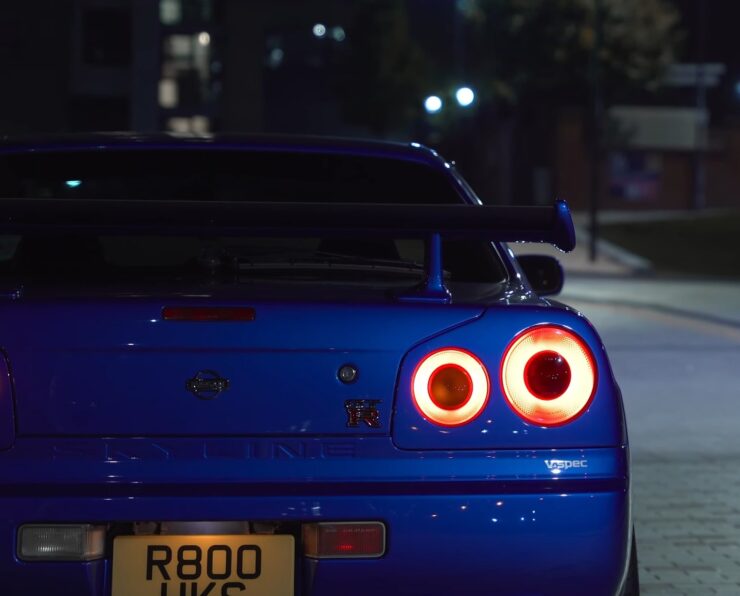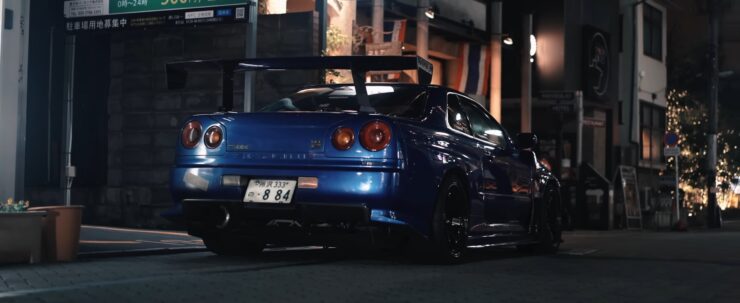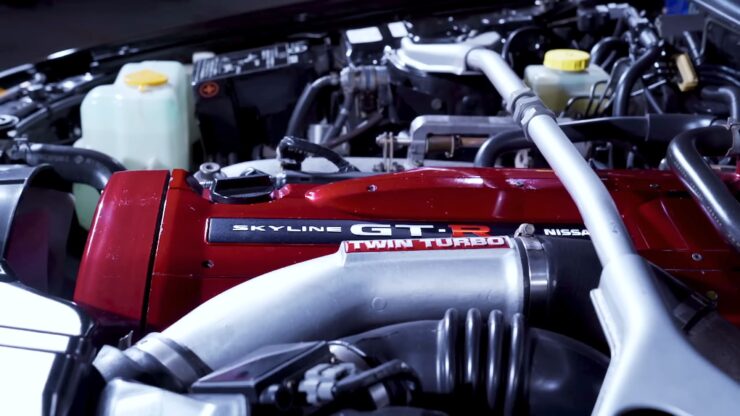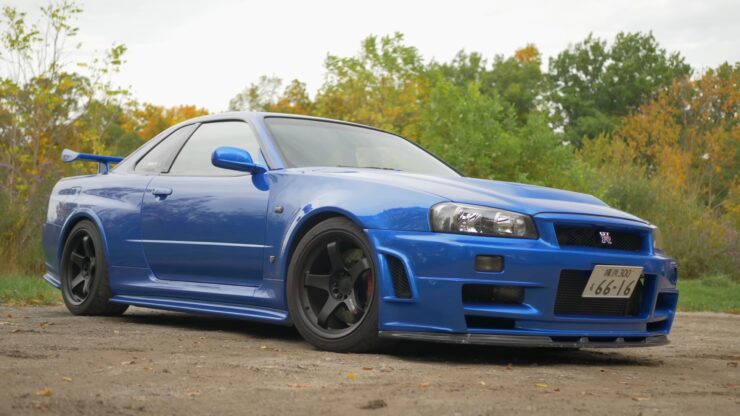Arguably one of the most iconic Japanese sports cars of all time, the Nissan Skyline GT-R R34 has gathered a cult following worldwide. It encompasses 40 years of automotive development, and it’s only getting more popular 30 years after production ended.
The Nissan Skyline GT-R lineage is one that has always captured the hearts of car enthusiasts worldwide. Ten years before Nissan introduced the R34, its predecessor, the R32 GT-R, had already garnered the nickname of “Godzilla.”
It was the beginning of a golden age for Japanese sports cars, with GT-Rs taking on and even outpacing most European and American rivals.
The R34, with its shorter production window compared to the R32 and R33 GT-Rs, is a rare gem. Nissan sold over 64,000 Skylines between 1998 to 2001, but only a fraction of those were the revered GT-Rs.
Production Numbers and Variations
Between 1999 and 2002, 11,578 GT-Rs left the factory in Musashimurayama. Nineteen of those cars would return to Nissan for a special upgrade. There are over a dozen variations of the R34 GT-R, including Series 1, Series 2, V-Spec, and M-Spec models.
Some were more brutal than others, featuring weight reduction upgrades and more. Finding a V-Spec II isn’t easy, with only 1,855 units built. The V-Spec II N1 is even rarer.
Nissan also celebrated the car’s connection with the Nurburgring race track, producing the V-Spec II Nur and M-Spec Nur for racing enthusiasts.
| Fuel Economy Metric (NEDC) | Value |
|---|---|
| City | 14.7 mpg US (16 L/100Km) |
| Highway | 26.1 mpg US (9 L/100Km) |
| Combined | 19.1 mpg US (12.3 L/100Km) |
The Powertrain: A Blend of Tradition and Innovation
A product of a bygone era, all R34 GT-Rs featured six-speed manual transmissions. Unlike the more entry-level Skylines, the BNR34 benefitted from AWD, specifically the ATTESA (Advanced Total Traction Engineering System for All-Terrain) ET-S Pro.
This system had torque-splitting capabilities, making even an average driver feel like a pro. Despite its advanced tech, the R34 GT-R was hefty, weighing over 3,400 lbs. But its heart, the RB26DETT engine, made that extra weight feel inconsequential.
The Engine: RB26DETT, A Tuner’s Dream
The RB26DETT, a 2.6-liter, twin-turbocharged, inline-six engine, had been in Nissan’s arsenal for over a decade before the R34’s introduction. With each generation, it received refinements and upgrades.
Performance and Potential
The last “Godzilla” of the 20th century had upgraded ball-bearing turbos, reducing the dreaded turbo-lag that plagued many boosted cars of the era.
While the official output was 276 horsepower due to the Japanese Gentlemen Agreement, many believe it was closer to 320 horsepower.
| Performance Metric | Value |
|---|---|
| Top Speed | 155 mph (249 km/h) |
| Acceleration 0-62 Mph (0-100 kph) | 4.9 s |
With forged pistons and a cast iron block, the RB26DETT’s tuning potential is legendary. Some enthusiasts have even pushed it to produce 1,000 horsepower with the right modifications.
The Nismo Z-Tune: The Ultimate
Nineteen cars were brought to the Omori factory for a special set of upgrades, resulting in the Nismo Z-Tune. With technology derived from Nissan’s GT500 and LeMans GT2 cars, the RB26DETT was transformed into the RB28.
This beast could produce 493 horsepower and 398 lb-ft of torque, launching the Z-Tune from 0 to 62 mph in just 3.8 seconds. Its top speed? A staggering 203 mph.
Track Dominance: Racing Pedigree
The R34 GT-R’s prowess wasn’t just limited to the streets. Its performance on the track was equally impressive, if not more so.
Nurburgring Achievements
Unofficially, the R34 GT-R completed a lap around the Nurburgring Nordschleife in just seven minutes and 52 seconds, with Kazuo Shimizu at the helm.
To put that into perspective, a Ferrari 360 Modena took eight minutes and nine seconds to complete the same lap that year. Even a Porsche 911 Turbo was slower by four seconds. The R34 time remains a testament to its engineering and performance capabilities.
Motorsport Successes
Beyond the Nurburgring, the R34 GT-R has a rich motorsport history. Delving into the All Japan Touring Car Championship reveals impressive results in the GT500 class, culminating with Masashi Motoyama’s title in 2003. The R34 GT-R’s legacy in motorsport is undeniable, further cementing its place as one of the greatest sports cars of all time.
The R34’s Cultural Impact
Beyond the racetrack and the winding roads, the R34 GT-R has left an indelible mark on global car culture. Its iconic status has been further cemented by its appearances in various forms of media and its influence on automotive enthusiasts worldwide.
The Silver Screen and Video Games
The R34 GT-R’s popularity skyrocketed, in part due to its appearances in movies and video games. Films like the “Fast and Furious” series showcased the R34’s prowess, making it a dream car for many.
Video games like “Gran Turismo” and “Need for Speed” allowed fans to virtually drive, modify, and race, further embedding its legendary status among younger generations.
A Symbol of JDM Culture
The R34 became a poster child for JDM (Japanese Domestic Market) enthusiasts. Car meets, shows, and events worldwide would often feature the R34 as a centerpiece, representing the pinnacle of Japanese engineering and design.
Its tunability and performance made it a favorite among modifiers and tuners, who would push the car’s limits in both style and speed.
The Rarity and Collectibility
As the years have passed, the R34 GT-R’s desirability has only increased, making it a hot commodity in the collector car market.
Skyrocketing Prices
With its limited production numbers, especially for specific models like the V-Spec II N1 and the Nismo Z-Tune, the R34 GT-R’s prices have soared.
Auctions have seen pristine examples fetch sums that rival European exotics. The car’s rarity, combined with its performance pedigree and cultural significance, has made it a must-have for many collectors.
The 25-Year Rule and the American Market
In the United States, the 25-year import rule has kept many R34 GT-Rs out of the country. However, as the R34 inches closer to this mark, there’s growing anticipation among American enthusiasts.
Many predict a surge in demand and prices as the R34 becomes legal for import, opening it up to a market that has been eagerly waiting for decades.
| Dimension Metric | Value |
|---|---|
| Length | 181.1 in (4600 mm) |
| Width | 70.3 in (1786 mm) |
| Height | 53.5 in (1359 mm) |
| Front/rear Track | 58.3/58.7 in (1,481/1,491 mm) |
| Wheelbase | 104.9 in (2664 mm) |
| Ground Clearance | 5.7 in (145 mm) |
| Cargo Volume | 6.4 cuFT (181 L) |
| Aerodynamics (Cd) | 0.33 |
The R34’s Lasting Legacy
While newer models like the R35 GT-R have taken up the mantle of Nissan’s performance flagship, the R34 remains a symbol of a golden era in Japanese automotive history.
A Benchmark for Performance
The R34 set standards that many cars still strive to achieve. Its blend of technology, performance, and design made it a benchmark for sports cars worldwide.
Even today, manufacturers look back at the R34 when designing their performance vehicles, hoping to capture some of its magic.
A Timeless Icon
The R34 GT-R’s design, with its aggressive lines, aerodynamic features, and iconic round tail lights, remains timeless.
It’s a car that still turns heads, whether on city streets, at car meets, or on the racetrack. Its influence on car design and performance will be felt for generations to come.
FAQ
1. Why is the Nissan Skyline GT-R R34 not street legal in the US?
The R34 is not street legal in the US primarily due to the 25-year import rule, which prohibits the import of certain foreign vehicles unless they are at least 25 years old.
The R34 does not meet several US safety and emissions standards, making it illegal to drive on public roads.
2. How much does cost today?
The price of an R34 GT-R varies based on its condition, model, and rarity. As of now, prices can range from $50,000 for a base model in decent condition to well over $400,000 for rare models like the Nismo Z-Tune in pristine condition.
3. What makes the RB26DETT engine so special?
The RB26DETT is renowned for its robust construction, tuning potential, and performance capabilities. With forged pistons, a cast iron block, and twin turbochargers, it’s an engine that can handle significant power upgrades without major modifications.
4. Are there any modern successors?
Yes, the Nissan GT-R (R35), introduced in 2007, is the spiritual successor to the R34. While it doesn’t carry the “Skyline” name, it continues the legacy of high-performance Japanese sports cars from Nissan.
5. How does the R34 GT-R handle compared to modern sports cars?
While technology and performance metrics have evolved, many enthusiasts believe that the R34 offers a raw, connected driving experience that is hard to find in modern vehicles. Its balance, AWD system, and manual transmission provide a unique driving sensation.
Conclusion
The Nissan Skyline GT-R R34 is more than just a car; it’s a legend. Its blend of performance, design, and cultural impact has solidified its place in automotive history.
Whether on the racetrack, in video games, or at car meets, the R34 continues to captivate and inspire. As the years go by, its legacy only grows stronger, reminding us of a golden era of Japanese automotive engineering.



















